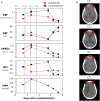Real-Time Non-invasive Assessment of Cerebral Hemodynamics With Diffuse Optical Spectroscopies in a Neuro Intensive Care Unit: An Observational Case Study
- PMID: 32411712
- PMCID: PMC7198738
- DOI: 10.3389/fmed.2020.00147
Real-Time Non-invasive Assessment of Cerebral Hemodynamics With Diffuse Optical Spectroscopies in a Neuro Intensive Care Unit: An Observational Case Study
Abstract
Prevention of secondary damage is an important goal in the treatment of severe neurological conditions, such as major head trauma or stroke. However, there is currently a lack of non-invasive methods for monitoring cerebral physiology. Diffuse optical methods have been proposed as an inexpensive, non-invasive bedside monitor capable of providing neurophysiology information in neurocritical patients. However, the reliability of the technique to provide accurate longitudinal measurement during the clinical evolution of a patient remains largely unaddressed. Here, we report on the translation of a hybrid diffuse optical system combining frequency domain diffuse optical spectroscopy (FD-DOS) and diffuse correlation spectroscopy (DCS) for real-time monitoring of cerebral physiology in a neuro intensive care unit (neuro-ICU). More specifically, we present a case study of a patient admitted with a high-grade aneurysmal subarachnoid hemorrhage, who was monitored throughout hospitalization. We show that the neurophysiological parameters measured by diffuse optics at the bedside are consistent with the clinical evolution of the patient at all the different stages following its brain lesion. These data provide support for clinical translation of DOS/DCS as a useful biomarker of neurophysiology in the neuro-ICU, particularly in locations where other clinical resources are limited.
Keywords: aneurysmal subarachnoid hemorrhage; cerebral blood flow (CBF); diffuse correlation spectroscopy (DCS); diffuse optical spectroscopy (DOS); neuro intensive care unit.
Copyright © 2020 Forti, Katsurayama, Menko, Valler, Quiroga, Falcão, Li and Mesquita.
Figures

Similar articles
-
Real-Time Monitoring of Neurocritical Patients with Diffuse Optical Spectroscopies.J Vis Exp. 2020 Nov 19;(165). doi: 10.3791/61608. J Vis Exp. 2020. PMID: 33283782
-
Prolonged monitoring of cerebral blood flow and autoregulation with diffuse correlation spectroscopy in neurocritical care patients.Neurophotonics. 2018 Oct;5(4):045005. doi: 10.1117/1.NPh.5.4.045005. Epub 2018 Nov 13. Neurophotonics. 2018. PMID: 30450363 Free PMC article.
-
Quantifying the Cerebral Hemometabolic Response to Blood Transfusion in Pediatric Sickle Cell Disease With Diffuse Optical Spectroscopies.Front Neurol. 2022 Jul 1;13:869117. doi: 10.3389/fneur.2022.869117. eCollection 2022. Front Neurol. 2022. PMID: 35847200 Free PMC article.
-
Optical approaches for neurocritical care: Toward non-invasive recording of cerebral physiology in acute brain injury.Neurotherapeutics. 2025 Jan;22(1):e00520. doi: 10.1016/j.neurot.2024.e00520. Epub 2025 Jan 17. Neurotherapeutics. 2025. PMID: 39827053 Free PMC article. Review.
-
Imaging in breast cancer: diffuse optics in breast cancer: detecting tumors in pre-menopausal women and monitoring neoadjuvant chemotherapy.Breast Cancer Res. 2005;7(6):279-85. doi: 10.1186/bcr1358. Epub 2005 Nov 28. Breast Cancer Res. 2005. PMID: 16457705 Free PMC article. Review.
Cited by
-
Non-Invasive Continuous Optical Monitoring of Cerebral Blood Flow after Traumatic Brain Injury in Mice Using Fiber Camera-Based Speckle Contrast Optical Spectroscopy.Brain Sci. 2023 Sep 25;13(10):1365. doi: 10.3390/brainsci13101365. Brain Sci. 2023. PMID: 37891734 Free PMC article.
-
Chassis-based fiber-coupled optical probe design for reproducible quantitative diffuse optical spectroscopy measurements.PLoS One. 2024 Jul 25;19(7):e0305254. doi: 10.1371/journal.pone.0305254. eCollection 2024. PLoS One. 2024. PMID: 39052686 Free PMC article.
-
Noninvasive Optical Monitoring of Cerebral Blood Flow and EEG Spectral Responses after Severe Traumatic Brain Injury: A Case Report.Brain Sci. 2021 Aug 20;11(8):1093. doi: 10.3390/brainsci11081093. Brain Sci. 2021. PMID: 34439712 Free PMC article.
-
Optical imaging and spectroscopy for the study of the human brain: status report.Neurophotonics. 2022 Aug;9(Suppl 2):S24001. doi: 10.1117/1.NPh.9.S2.S24001. Epub 2022 Aug 30. Neurophotonics. 2022. PMID: 36052058 Free PMC article.
-
Pathlength-selective, interferometric diffuse correlation spectroscopy.IEEE J Sel Top Quantum Electron. 2025 Jul-Aug;31(4):7400814. doi: 10.1109/jstqe.2025.3575719. Epub 2025 Jun 2. IEEE J Sel Top Quantum Electron. 2025. PMID: 40766943
References
-
- Vergouwen MDI, Vermeulen M, van Gijn J, Rinkel GJE, Wijdicks EF, Muizelaar JP, et al. . Definition of delayed cerebral ischemia after aneurysmal subarachnoid hemorrhage as an outcome event in clinical trials and observational studies. Stroke. (2010) 41:2391–5. 10.1161/STROKEAHA.110.589275 - DOI - PubMed
Publication types
LinkOut - more resources
Full Text Sources

